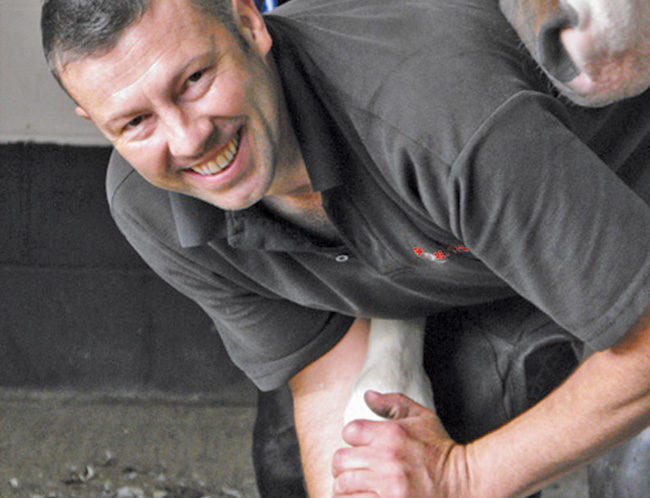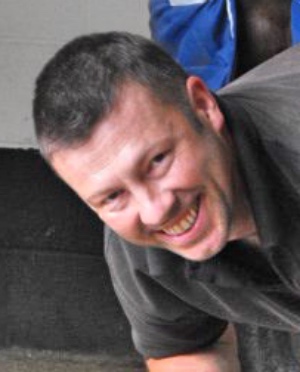Accidents certainly can happen when farriers are working with horses, but one is always hopeful that it won’t happen to you.
Since the majority of farriers work alone and are self-employed, the ability to earn money and support their families is dependent upon being able to get under horses every day. After all, you don’t get paid for sitting at home.
Trimming and shoeing is an extremely hazardous occupation. Farriers risk burns, cuts, kicks and bites — not to mention the wear and tear on backs, knees, hips, elbows and wrists.
In my 23 years as a British farrier, I’ve had my fair share of injuries. Being able to deal with injuries seems to go along with becoming a successful farrier. Based on my experience, the average farrier will sustain a work-related injury, which will necessitate time off from work, approximately once every 5 years.
With these odds, you need to develop a contingency plan for when this happens to you — and it will happen. Let me relate how I learned the importance of having a plan of attack in place when I was injured by a horse as outlined in the accompanying sidebar.
“I’ve Got To Work”
As I was lifted into the ambulance at the barn following my accident, the idea was already running through my mind as to when I could get back to work. As ridiculous as it now seems, I was convinced I’d be back working in a few days.
I figured I had no choice but to quickly return to work. After all, I had a family to support, bills to pay and clients who depended on me to provide needed hoof care.
Over the next few weeks I had plenty of time to evaluate the situation and how it would affect my clients and my ability to make a living. I know many farriers who have sustained serious injuries and had to be away from their businesses for a few months. Once they were fit and able to return to work, many clients had drifted away to other farriers— never to return.
The reality is that nobody is indispensable. No matter how loyal you think clients are, you’ll lose some of them if you are away from your business for even a brief period of time. Yet how many you lose and how many you keep is entirely up to you.
Client Communication Critical
Whether you’re working or not able to work due to an injury, the success of your business is solely dependent on how you communicate with clients and/or potential clients.
Modern technology and social media has greatly accelerated the speed in which we are able to communicate with clients and colleagues. But to communicate effectively and quickly, you need to have previously accumulated the correct client contact details.
The popularity of smart phones has dramatically changed our lives. What was once just a basic cell phone has evolved into a crucial social-media asset that can effectively improve your interaction with clients.
After my pain levels had been managed, the first thing I did was text those clients who had been scheduled for visits by me over the next few days. I notified them of the circumstances of my injury and told them that I’d be updating them once I had a better idea of how I’d be doing after surgery.
I quickly realized how essential it is to have all of these client contact details stored in one convenient place. Back in the old days, I logged each client’s home address, home and work numbers in an old battered address book. Now I have all of the details for each client stored in my smart phone.
Once each client’s name, home address, email address and home/work/cell phone numbers are compiled in your phone, the data should also be backed up on your computer along with a printed hard copy for easy reference. I’ve also found it useful to list all individual clients and not just record data on the barn manager who may supervise your visits.
Get Word Out Quickly
Next, I contacted local farriers to inform them about my serious accident. I did this out of courtesy and respect, as I knew they would soon hear about my injury. However, I wanted them to hear the details and concerns firsthand from me and not from my clients.
By taking this critical step, I was able to determine which farriers would be able to offer short-term hoof-care coverage for my clients.
Social networking sites such as Facebook and Twitter are a phenomenal way to communicate and promote your business. By using both my separate personal and business accounts, I kept clients updated on the progress of recuperation. These sites also provided clients with a forum where they could give me needed feedback.
I can’t emphasise enough the importance of keeping client contact details updated, especially cell phone and email addresses. The use of a smart phone enables you to have quick and easy communication with clients and other farriers by sending out group emails and text messages.
If you find yourself isolated in a hospital ward as I did without access to your business records or internet access, a smart phone can serve as a very valuable client communications tool.
Insurance, Health Care Concerns
It’s been said many times that you won’t know how well you’re insured until you have to make a claim. I’ve used the same insurance broker for income protection since I started running my own business 18 years ago. Each year the policy would automatically renew and a new printed policy (almost the size of a telephone directory) would arrive in the mail. I hardly read any of the details when the policy arrived each year. But as it turned out, it was a mistake to not know the extent of coverage since I thought I was fully covered.
I contacted my insurance company the day after my accident (make sure you have their number stored in your phone) and a week later received the claim form.
The small print stated that the claim form had to be returned within 2 weeks of the accident, as they would not be able to backdate any payments. With a week already gone by and a weekend coming up, this meant the form had to be filled out by the insurance consultant, surgeon and doctor within 3 days to avoid receiving reduced payments.
I’d been under the assumption that there was a 4-week waiting period for which I would not receive payment for any lost business income. Yet I was unaware that even after a month off, I still had to wait another 2 weeks to be paid retrospectively. As a result, I went 6 weeks with no insurance payments to offset my lost hoof-care income.
Due to an earlier restructuring of my farrier business to reduce the tax liabilities by making my wife a partner, the business loss payments were reduced significantly. We learned that income protection here in Great Britain only covers a percentage of the policyholder’s taxable income rather than the actual business income itself.
After receiving a payment from my health care insurer, they sent me a form a week later requesting a detailed account of the accident. This was when I learned the health insurance company wanted the detailed account of the injury so they could take legal action against the horses’ owner to recoup payments made to me.
Regardless of how I might feel about who was to blame for this situation, I was contractually obliged to provide the information.
It is essential that you be properly insured to provide needed accident coverage whether there is a case for negligence or not. In addition, make sure you have insurance coverage suitable for your particular occupation and needs. Be mindful of any change in your particular circumstances by reviewing and discussing these policies on an annual basis with your insurance brokers.
You also need to realize that the insurance provider may seek legal action against your client. Regardless of your own viewpoint about the accident, British farriers have learned that this may have a bearing on future farrier and client relationships.
In addition, make sure all insurance documents are filed in a safe place known to your spouse or partner.
Getting Home
Dealing with on going business needs was much easier once I got home and had access to my computer and client database. Yet I was anxious to see how I’d be able to cope minus a finger.
After arriving home, the first thing I did was send an email to all of my clients updating them as to which farriers would be covering their horses for me and providing an estimated date for when I hoped to return to work.
I subcontracted some work to a newly qualified area farrier who used my shoeing vehicle. Although I couldn’t work, it was good to accompany him at times and show my face again.
I had regular physical therapy and needed pain relief for a month after leaving the hospital.
Prior to returning to full-time work, I shod a few horses to see what I could do. What I struggled with most was picking up nails with my fingers and nailing on shoes. While my overall fitness also suffered, I was able to overcome this rapidly as the mind and body are incredibly adaptable.
Overall, I was off work for 8 weeks.
Not If — But When
Sometime during your farrier career, you’re going to get hurt. Be aware of the risks your profession presents, do all you can to reduce these risks and be properly prepared for such an emergency.
Communicate to your clients the type of environment and safety precautions that are needed in the area where you work in a barn. This means providing clients with a list of terms and conditions (including payment requirements) before you start to work on their horses.
Clients are not mind readers and may think you’re perfectly happy catching, trimming and shoeing a group of yearlings that are wandering around the paddock. Or they may think you have no concerns when their terrier runs between the horse’s legs picking up hoof clippings while you’re trimming and shoeing.
Take the time to make sure your client or a horse is worthy of your skills and efforts. Many farriers pride themselves in shoeing badly behaved horses, but it’s seldom worth the risk.
Discuss an injury contingency plan with your spouse or partner if an accident is to occur. Does he or she know where all of your important documents are filed or where on the laptop client contact details are located?
I keep a large sealed envelope pinned up in the back of my truck cab. On the envelope, I’ve used a black marker pen to print in large type my emergency contact number. Inside the envelope, I’ve printed my home telephone number and my wife’s cell phone number.
When a serious accident occurs, you can expect to lose some footcare accounts. But by taking the necessary steps and making the effort to keep clients and other farriers informed, you’ll show that you care about them, the health of their horses and that you will make sure the hoof-care needs are handled while you are out of action.
The worst thing to do when you get hurt is to drop below the radar and pop up 8 weeks later, expecting your clients to welcome you back with open arms.
Since nobody is indispensable, take the necessary steps to keep your business operating through effective client communication. And never work on horses alone, as it could cost you your life.









Post a comment
Report Abusive Comment